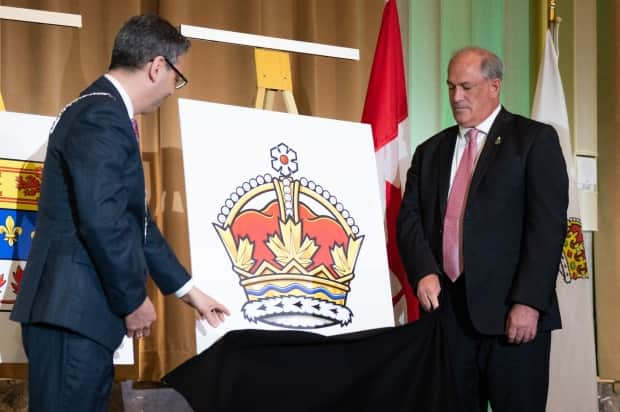King Charles III will replace his mother on Canadian $20 bill and coins

King Charles III will replace his predecessor, the late Queen Elizabeth II, on Canada's coins and $20 bill after officially being crowned Canada's sovereign.
President and CEO of the Royal Canadian Mint, Marie Lemay, told CBC that the process of making the official effigy of Charles that will adorn Canada's currency has several steps.
First the Mint will have to invite artists to express interest and submit proposed designs. Once one is chosen, it will need to be finalized and approved by Buckingham Palace.
"We expect to be able to share the selected design in the fall, so I think that will be a big moment," Lemay said, but added that it would still be a number of weeks before new coins enter circulation.
Charles's likeness on Canada's coins will also be facing left, as opposed the ones bearing his mother's image, who faces right.
The process of creating a new $20 bill is expected to take a few years. Current Canadian money bearing the likeness of Elizabeth II will remain legal tender.
WATCH | Highlights from the coronation:
Canadian ceremony in Ottawa
The Canadian ceremony marking the coronation of the new King was held in the nation's capital Saturday morning. The ceremony at the Sir John A. MacDonald building in Ottawa included speeches, musical performances and a 21-gun-salute.
After some brief opening remarks, Algonquin poet and spiritual adviser Albert Dumont made a statement reflecting on Indigenous people's past and future relationship with the Crown.
"The trees sway joyfully in remembrance of a time long ago before the power of the British sword destroyed the tranquility of gentle Turtle Island," he said. "Today, a vow made from afar brings hope that honour will again grace the circle from which the wampum of peace and friendship is held tightly… by the good spirit."
Charles met with Indigenous leaders earlier this week who said they hope the meeting marks the beginning of a new chapter in the relationship between the Crown and Indigenous Peoples.
Dumont's statement was followed by an Algonquin circle drum performance by the Eagle River Singers. Other musical performances from the ceremony included Quebec's Florence K and P.E.I.'s Inn Echo.
New coins, stamp depicting King Charles
While the ceremony In Ottawa was fairly subdued compared to the one held in the U.K., it marked some changes to Canada's royal symbols.
Along with plans for new currency images showcasing pictures of King Charles, the Royal Canadian Mint unveiled a new set of collector coins marking the occasion. Likewise, Canada Post unveiled a stamp depicting King Charles, continuing a more than 170-year tradition of issuing postage stamps bearing the face of Canada's sovereign.
Procurement Minister Helena Jaczek, who is responsible for Canada Post, said unveiling the new stamp was "a wonderful way to commemorate the historic moment."
"The coronation is a momentous occasion for Canadians and people throughout the Commonwealth," she said. "It is only fitting that it be celebrated on a Canadian stamp, continuing a long-standing tradition."
'Uniquely Canadian' crown design
The government also unveiled a new design of the Canadian crown, a symbol which sits atop Canada's coat of arms.
The previous crown featured symbols such as a cross at the top and a circlet of gold crosses and Fleur-de-Lys. The new iteration replaces those symbols with a likeness of an Order of Canada Medal on top and a ring and gold maple leaves.

Minister Bill Blair, president of the King's Privy Council, said the new design is "uniquely Canadian." He noted that the new crown also includes a wavy blue line meant to represent Indigenous teachings about the importance of Canada's waterways.
"Our royal symbols must be inclusive to unite as Canadians and they must also be unique to distinguish us in the world," he said.
"One of the strengths of our constitutional monarchy is its ability to adapt. We have come a long way since 1867 and our symbols have changed to reflect this development," he said.
Provincial and territorial ceremonies were also held by Canada's lieutenant-governors and territorial commissioners.
Coronation a 'momentous occasion': Trudeau
Charles, a man who waited almost 74 years to become King, was crowned earlier Saturday at Westminster Abbey with all the pomp and pageantry Britain could muster.
Shouts of "God save the King" rang out and trumpet blasts echoed in the abbey after Archbishop of Canterbury Justin Welby placed St. Edward's Crown on the monarch's head.
WATCH | See the moment King Charles is crowned:
Prime Minister Justin Trudeau and Gov. Gen. Mary Simon were among those in attendance at the ceremony.
"As we celebrate this momentous occasion, let us be reminded of our shared values of inclusivity, diversity, and respect for human rights as we work together to build a better future for all members of the Commonwealth," Trudeau said in a statement.
Simon also released a statement Saturday, saying it was a "great honour" to witness the coronation.
"Seventy years have passed since the last Coronation, offering us an opportunity to reflect on all that has changed in our country, the Commonwealth and the world around us," Simon said.

"While the Crown has also evolved during this time, it continues to be an anchor for our robust and stable democracy and our diverse country."
Charles had taken an oath to govern the people of the United Kingdom with "justice and mercy" and to foster an environment where people of all faiths and beliefs can live freely. The oath was the second of five elements of the historic coronation rite that is rooted in more than 1,000 years of tradition.

